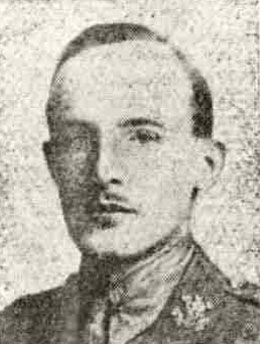Lieutenant Robert Arthur Arland Macready, MC

Robert Arthur Arland Macready was born on 30 May 1895 at Irvinestown, County Fermanagh, eldest son of bank manager Robert Macready and his wife Henrietta Isabel (nee Battersby). By 1911 he was living at 7 Balfour Avenue, Templecorran, County Antrim, with his widowed mother, sister and two brothers.
Macready was educated at the Royal Academical Institution, and Shaftesbury College, Belfast, before finding employment as a motor mechanic.
He enlisted in the North Irish Horse at Larne on 4 September 1914 (No.1131), and embarked for France as part of D Squadron on 1 May 1915.
Macready applied for a commission in the Leinster Regiment on 2 October 1915. He was made a 2nd lieutenant on 1 January 1916, posted to the 3rd (Reserve) Battalion, Leinster Regiment, and ordered to join the School of Instruction at Cork.
At the end of 1916 he was attached to the 2nd Battalion, Leinster Regiment, joining them in the field at Les Brebis on the Loos front on 10 December. On 10 January the following year Macready was part of a major raid by the battalion on the enemy trenches near Maroc. The war diary for that day states:
At 4.20 pm a raiding party which had been training in Les Brebis crossed no man's land under cover of a smoke barrage and entered the enemy's trenches on both sides of the apex of the Triangle capturing 8 prisoners and inflicting considerable losses of the enemy. Several deep dug outs were bombed. Our party returned under cover of an intense artillery barrage. A bombardment near Harrison's had previously attracted the enemy's attention. Great assistance was given by one of our aeroplanes which flew low over the raided area, inflicting damage by M.G. fire, thereby distracting the attention of hostile M.G. and observers. Our casualties – Lt C.L.P. Heming wounded. 19 O.R. wounded. 2 O.R. missing. 1 O.R. killed.
For his role in the raid, Macready was awarded a Military Cross. His citation states:
For conspicuous gallantry in action. He displayed great courage and initiative during a raid against the enemy's trenches. He himself bombed several dugouts and killed two of the enemy. Later, he assisted to carry a dead man back to our lines under heavy fire.
The following month during a routine patrol Macready "fell astride a beam of wood in a shell-hole and bruised the right testicle." The injury was serious enough to see him evacuated to England for treatment. This and a series of other illnesses, including the need for major dental work, saw Macready confined to officers' hospitals and on home duty with the 3rd Leinsters until mid 1918. During this time (on 1 July 1917) he was promoted to lieutenant.
On 31 July 1918 he again embarked for France, joining the 2nd Leinsters in the field on 16 August. However five days later at Bailleul his left knee was struck by a piece of sheeting, causing a contusion severe enough to warrant his evacuation to England for treatment. It was some time before he was fit for general service.
Macready was demobilised on 21 October 1919 and relinquished his commission on 1 April 1920.
On 12 May 1921 he married Thurfrida Rowena Winifred Barlowe at Glencraig, County Down.
Macready served in the Auxiliary Division of the Royal Irish Constabulary from March 1921 until it was demobilised in January the following year.
In 1925 he attempted to enlist in the army but was rejected on account of being a married man. After a series of appeals, on 19 May he was accepted as a sapper in the Royal Engineers (No.1864070), having first formally relinquished his rank of lieutenant.
Macready remained with the regiment for many years. He died at Gibraltar on 19 October 1940 while serving in No.1 Fortress Company, and is buried in the Gibraltar (North Front) Cemetery, grave II.D.20. His gravestone inscription reads:
1864070 SAPPER
R.A.A. MACREADY, MC.
ROYAL ENGINEERS
19th OCTOBER 1940 AGE 45
FEAR GOD
LOVE THE BROTHERHOOD
HONOUR THE KING


Image of Macready sourced from the Larne Times and Weekly Telegraph, 10 March 1917. Images of Macready's gravestone and Gibraltar provided bySteve Rogers, Project Co-ordinator of the The War Graves Photographic Project. Information about the Auxiliaries sourced from the website The Auxiliary Division of the Royal Irish Constabulary.
